I had the same problem as your friend with his Blackwater. I couldn't keep the Shadow straight. I am not a bad paddler (finished the 90-miler a couple of times) but I think my technique was a problem with the Shadow. The other possibility is I don't weigh enough to get the Shadow in the water (that is a guess). Regardless, I didn't have this problem with other canoes I have owned (or own) ...Magic, XL Classic, Hemlock Kestrel. I have heard great things about the Blackwater, and now they make a shorter version. But, given my history with canoes i would have to try it and that is difficult. I have paddled both the Rapidfire and the Cruiser (there is a Swift dealer near me) and I like both very much. So, if I can get either one used I will jump on it.
-
Happy Dewey Decimal System Day! 📚🔢
You are using an out of date browser. It may not display this or other websites correctly.
You should upgrade or use an alternative browser.
You should upgrade or use an alternative browser.
Thoughts on Grasse River/GRB Newman Classic?
- Thread starter tketcham
- Start date
Well, I picked up my GRB Newman Classic canoe a couple of weeks ago and have taken it out four times so far. It rained most of last week so I didn't get out much. I was getting used to the canoe the first couple of times but added seat risers, padding, and foot brace loops and yesterday and today I got out for 6+ mile paddles. I'm still learning the canoe's capabilities (well, learning what my weaknesses are with this capable boat) and I'm liking its potential, especially in today's 10 - 20 mph wind and small white caps. (There was just over a mile of fetch.) When heading into the wind the flared bow section helped ride over more than a few waves and when headed down wind the canoe has a fairly predictable "surfing" action, though you do have to pay attention. For such a fast touring canoe it felt pretty comfortable in today's conditions and I think once I get more familiar with the canoe I'll be OK with taking it out in even rougher water, though fighting the wind takes the fun out of it. : )
I tracked my route with a Garmin GPS today and below is the result. The wind was blowing from the west/southwest so you can see how it affected my progress, with the fastest speeds along the somewhat protected shorelines. (I wasn't trying to go all out but kept a decent pace.) I also slowed down while broadside to the waves and "surfing" because I'm still a bit tentative in this canoe. But I think I can get faster overall speeds once I'm more comfortable in the boat and certainly on a calmer day. This canoe should be able to really cover some water on a trip. I'm hoping to get out for a quick overnight test paddle with this canoe in October.
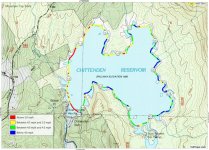
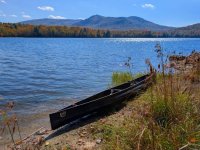
I tracked my route with a Garmin GPS today and below is the result. The wind was blowing from the west/southwest so you can see how it affected my progress, with the fastest speeds along the somewhat protected shorelines. (I wasn't trying to go all out but kept a decent pace.) I also slowed down while broadside to the waves and "surfing" because I'm still a bit tentative in this canoe. But I think I can get faster overall speeds once I'm more comfortable in the boat and certainly on a calmer day. This canoe should be able to really cover some water on a trip. I'm hoping to get out for a quick overnight test paddle with this canoe in October.


Last edited:
Oops. Photo moved to previous post.
Last edited:
Went back up to Chittenden Reservoir this afternoon to give the new Classic a good test paddle with mild wind. A breeze from the south rippled the surface and created small waves but no white caps this time so I didn't have to slow down much when broadside to the waves and I wasn't fighting a gusty headwind. You can clearly see where I had to slow down to get through a rocky narrow and where I stopped for a quick snack and drink of water. I'd say overall, at least a mile/hour faster this trip. Haven't cleaned up the GPS data to get an accurate average speed but my estimate is between 4.5 and 5.0 miles per hour. I really like this canoe. It's fast, predictable, and efficient. When at speed it doesn't feel like it's wearing you down. Haven't taken it out for an overnight trip yet but it seems like it'll be a great tripping canoe if you pack like a backpacker.
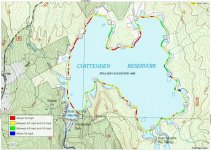

Last edited:
That GRB classic definitely looks fast. Thanks for sharing your experience with the sweet new boat. I can only hope to get a chance at any of those mentioned in this thread.
I have a question as an aside...
I have a question as an aside...
Will you give some details about those loops?added seat risers, padding, and foot brace loops
The foot brace loops are something I read about in "Canoe Racing" by Peter Heed and Dick Mansfield; 1992. I've seen similar straps set up in marathon canoes. I tried them many, many years ago and didn't like them but thought I'd give it another try. Now I like the foot straps a lot because they provide extra leverage when working with waves. Sort of like thigh straps in a white water canoe.
Here's my version and the set up shown in "Canoe Racing". I still need to adjust them so the straps are angled upward a bit more.
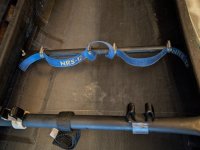
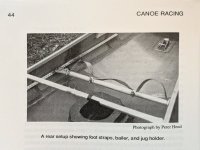
And while I'm at it, here are the seat modifications, including padding, 1" rear risers, 0.5" front risers, and a spring clip for seat adjustment. I prefer some forward tilt to the seat and a little more seat height; it comes with 1/4" risers. YMMV.
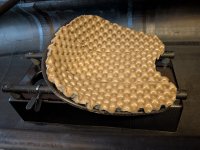
Here's my version and the set up shown in "Canoe Racing". I still need to adjust them so the straps are angled upward a bit more.


And while I'm at it, here are the seat modifications, including padding, 1" rear risers, 0.5" front risers, and a spring clip for seat adjustment. I prefer some forward tilt to the seat and a little more seat height; it comes with 1/4" risers. YMMV.

Last edited:
The foot brace loops are something I read about in "Canoe Racing" by Peter Heed and Dick Mansfield; 1992. I've seen similar straps set up in marathon canoes. I tried them many, many years ago and didn't like them but thought I'd give it another try. Now I like the foot straps a lot because they provide extra leverage when working with waves. Sort of like thigh straps in a white water canoe.
Here's my version and the set up shown in "Canoe Racing". I still need to adjust them so the straps are angled upward a bit more.
View attachment 150426View attachment 150427
And while I'm at it, here are the seat modifications, including padding, 1" rear risers, 0.5" front risers, and a spring clip for seat adjustment. I prefer some forward tilt to the seat and a little more seat height; it comes with 1/4" risers. YMMV.
View attachment 150428
Thanks! I never thought of doing that with a foot bar, but I can imagine how it would be helpful sometimes. And minimal added weight. I'll keep that trick in mind for the Solitude.
I like the foot straps a lot because they provide extra leverage when working with waves. Sort of like thigh straps in a white water canoe.
So, just to be clear, they allow you to pull back on the foot bar?
Yup. I mix it up between pushing into the bar or pulling away from the bar to help balance/heel the canoe depending on what's going on. It's handy keeping the hull heeled away from the waves when broadside and when you're wanting to turn. One thing I've changed is that I had learned that you push against the bar on the stroke side to enforce the pull on the blade, kind of/sort of like rowers but with only the onside leg. It does work but I started pulling on the same side as the paddle stroke and pushing on the opposite (off) side and found it helps in keeping the canoe subtly heeled away from the paddle side and subtly counters the yaw of the stroke. I just alternate between 'hits'. It was new to me but seems to work.So, just to be clear, they allow you to pull back on the foot bar?
Last edited:
I've moved several posts about what leg to push off with and the effect of heeling on forward velocity to a new, separate thread because they have become tangential to the discussion of the GRB Newman Classic canoe and because they are interesting enough to warrant their own thread.
What leg to push off of. Effect of heeling on forward velocity.
I started pulling on the same side as the paddle stroke and pushing on the opposite (off) side and found it helps in keeping the canoe subtly heeled away from the paddle side and subtly counters the yaw of the stroke. I just alternate between 'hits'. Tom, I'm not clear on this because I am not...
www.canoetripping.net
Thanks for sharing all of this. My two year plan involves getting another canoe specifically for lakes, and the GRB Classic is definitely on the short list. I would not be sad if you shared a few more of these when you can get back out on the water.
It's getting cold up here (water and temps) so I won't be going out much more this year. I noticed you have a Northstar Trillium. I have a Hemlock Kestrel, which is similar, and I think you'll appreciate the added performance of the Classic if you're wanting a faster boat. The Classic is more tender than the Trillium/Kestrel but has plenty of secondary stability for such a fast solo.Thanks for sharing all of this. My two year plan involves getting another canoe specifically for lakes, and the GRB Classic is definitely on the short list. I would not be sad if you shared a few more of these when you can get back out on the water.
Yea it's getting pretty chilly down here as well, I'm sad for you that you got such a nice boat at the tail end of the season. I actually got to meet Max (It looks like he's taken over production of GRE) after the ADK 90 this year, and we spent about 15 minutes looking over the GRE Classic he just finished the event with. I could definitely see the characteristics your referencing when he flipped it over.
While I was in the Adirondacks I paddled a Northstar Magic (loved it) and a Cruiser 16.8 (I don't weigh enough) as well. But there's something about the GRE Classic...I'll definitely need to paddle one before I make a final decision. Fortunately I have time, I think I need to spend some more time brushing up my skills with the Trillium first.
While I was in the Adirondacks I paddled a Northstar Magic (loved it) and a Cruiser 16.8 (I don't weigh enough) as well. But there's something about the GRE Classic...I'll definitely need to paddle one before I make a final decision. Fortunately I have time, I think I need to spend some more time brushing up my skills with the Trillium first.
The Magic is a great canoe and the Magic and the Classic are comparably fast as touring boats. I'd give the edge to the Classic for speed but the Magic has a lot going for it as a solo touring canoe and day tripper.
Similar threads
- Replies
- 20
- Views
- 2K
- Replies
- 6
- Views
- 1K
